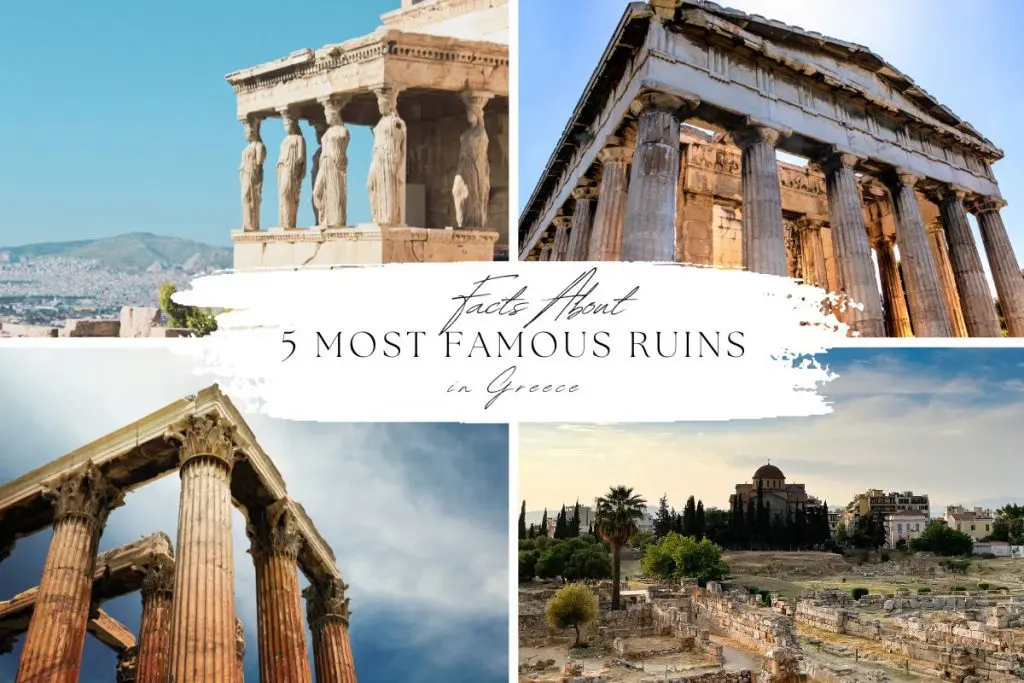
Visiting the 5 Most Famous Greek Ruins, including those in Athens and other ancient sites, is often considered a highly worthwhile experience. Greece is renowned for its rich history, and these archaeological sites provide a tangible connection to the ancient Greek civilization, which has greatly influenced Western culture.
Here are some reasons why visiting 5 Most Famous Greek Ruins can be worthwhile:
Historical Facts: Greece is home to some of the most important and iconic archaeological sites in the world, such as the Acropolis in Athens, the Temple of Apollo in Delphi, and the ancient theater of Epidaurus. These sites have played a crucial role in shaping the history and culture of Western civilization.
Architectural Marvels: The ancient Greeks were masterful architects, and their ruins showcase remarkable achievements in design and engineering. The Parthenon on the Acropolis, for example, is celebrated for its classical Doric architecture and aesthetic appeal.
Cultural Exploration: Exploring Greek ruins allows visitors to delve into the cultural and religious practices of ancient Greece. The temples, theaters, and agora provide insights into daily life, religious ceremonies, and civic activities.
Scenic Beauty: Many archaeological sites in Greece are situated in picturesque landscapes, offering breathtaking views and a pleasant atmosphere. The combination of historical significance and natural beauty enhances the overall experience.
Visiting these sites provides an educational opportunity to learn about ancient history, mythology, and the contributions of ancient Greece to various fields such as philosophy, science, and art.
Standing amidst ancient ruins can create a profound sense of connection to the past. It’s a chance to reflect on the continuity of human civilization and appreciate the enduring legacy of ancient Greek culture.
While individual preferences may vary, for many travelers, the chance to witness the tangible remnants of ancient Greece is a unique and enriching experience. Whether you have an interest in history, architecture, or simply enjoy exploring culturally rich destinations, visiting Greek ruins can be a rewarding and memorable journey.
Here are some facts about the 5 Most Famous Greek Ruins…
Acropolis of Athens
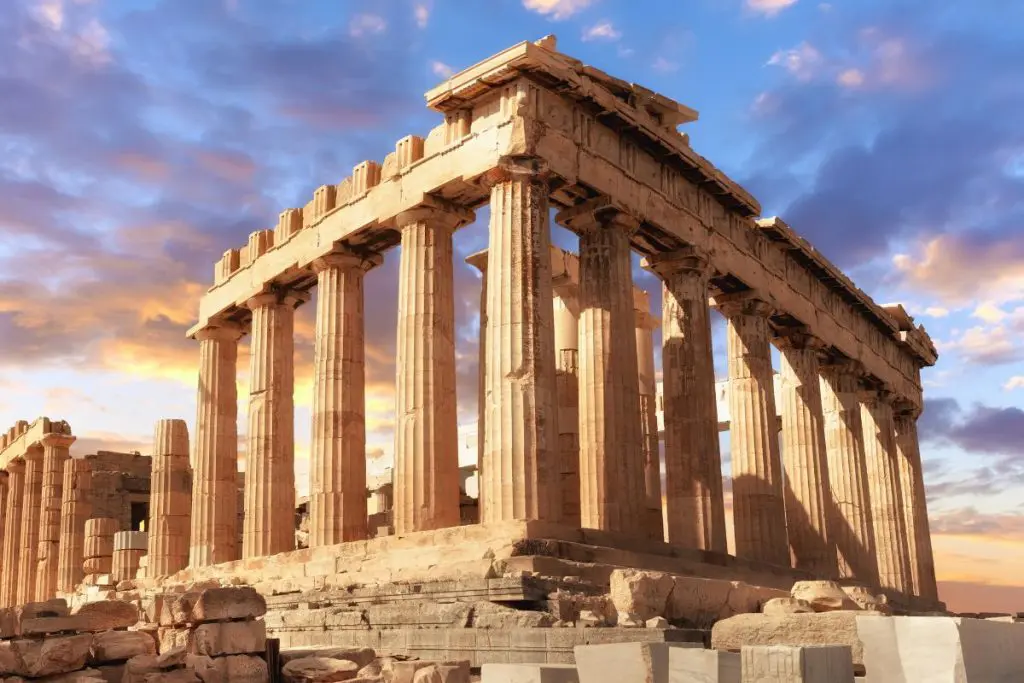
The Acropolis of Athens is located in Athens, Greece. It is a prominent ancient citadel situated on a rocky outcrop above the city, and it contains several historic buildings of great architectural and cultural significance, the most famous being the Parthenon. The Acropolis is a UNESCO World Heritage Site and a symbol of ancient Greek civilization which make Acropolis one of the Most Famous Greek Ruins.
Who Build Acropolis of Athens?
The construction of the Acropolis of Athens began in the 5th century BCE during the Golden Age of Athens. The project was initiated by Pericles, the influential statesman and general of ancient Athens. The Acropolis was built as a complex of structures dedicated to the city’s patron goddess, Athena. The most famous building on the Acropolis is the Parthenon, a temple dedicated to Athena Parthenos (Athena the Virgin), and it is considered one of the greatest achievements of classical Greek architecture. The construction involved various architects, sculptors, and workers, with contributions from notable figures like the architect Ictinus and the sculptor Phidias.
Things to see at Acropolis of Athens
The Acropolis of Athens is a UNESCO World Heritage Site and a symbol of ancient Greek civilization. When visiting the Acropolis, there are several key attractions and structures to explore. Here are some of the main things to see at the Acropolis:
Parthenon: The Parthenon is the most iconic and significant structure on the Acropolis. It is a Doric temple dedicated to the goddess Athena and is renowned for its classical architecture. The Parthenon has survived through the ages and is considered one of the greatest achievements of ancient Greek art and engineering.
Erechtheion: This temple is located on the north side of the Acropolis and is dedicated to both Athena and Poseidon. It is known for its Caryatid Porch, featuring six female figures serving as columns. The Erechtheion is an example of Ionic architecture.
Propylaea: The Propylaea is the monumental gateway to the Acropolis. It consists of a central building with two wings and serves as the entrance to the sacred precinct.
Temple of Athena Nike: This small Ionic temple is dedicated to Athena Nike, the goddess of victory. It is located on the southwest side of the Acropolis and is known for its elegant design.
Acropolis Museum: While not located on the Acropolis itself, the Acropolis Museum is nearby and is a must-visit. It houses a vast collection of artifacts and sculptures from the Acropolis, providing additional context to the site.
Theater of Dionysus: Located on the southern slope of the Acropolis, the Theater of Dionysus is one of the earliest theaters in Athens and served as the venue for ancient Greek dramas and festivals.
Odeon of Herodes Atticus: This well-preserved ancient theater is located on the southwest slope of the Acropolis. It was built in the 2nd century AD and is still used for performances today.
Sanctuary of Asclepius: Situated on the south side of the Acropolis, this sanctuary includes the Asclepius Theater and the Asklepieion, dedicated to the god of healing, Asclepius.
When visiting the Acropolis, it’s advisable to take your time to appreciate the historical and architectural significance of each structure. Additionally, consider exploring the surrounding archaeological sites and museums to gain a comprehensive understanding of ancient Greek culture and civilization.

FAQs about Acropolis of Athens
The Parthenon is a Doric temple on the Acropolis dedicated to the goddess Athena Parthenos. It is one of the most iconic and well-preserved ancient Greek temples.
The Acropolis holds immense historical and cultural significance as a symbol of ancient Greek achievements in art, architecture, and philosophy. It is considered a UNESCO World Heritage Site.
Besides the Parthenon, the Acropolis includes structures like the Erechtheion, the Propylaea (gateway), and the Temple of Athena Nike. Each has its own architectural and historical importance.
The Acropolis is easily accessible in the city center of Athens. Visitors can walk from the Plaka district or take public transportation, including buses and the metro.
Situated in the city of Athens, the Acropolis rests on a gently elevated rock, reaching a height of 150 meters (490 feet) above sea level, and it spans approximately 3 hectares (7.4 acres) in surface area.
Yes, photography is generally allowed at the Acropolis. However, there might be restrictions in certain areas or during special exhibitions, so it’s advisable to check on-site regulations.
The Acropolis is popular throughout the year, but early morning or late afternoon visits may offer a less crowded experience. Spring and fall are often considered ideal seasons due to milder weather.
Location on Map
Temple of Zeus (Olympieion)
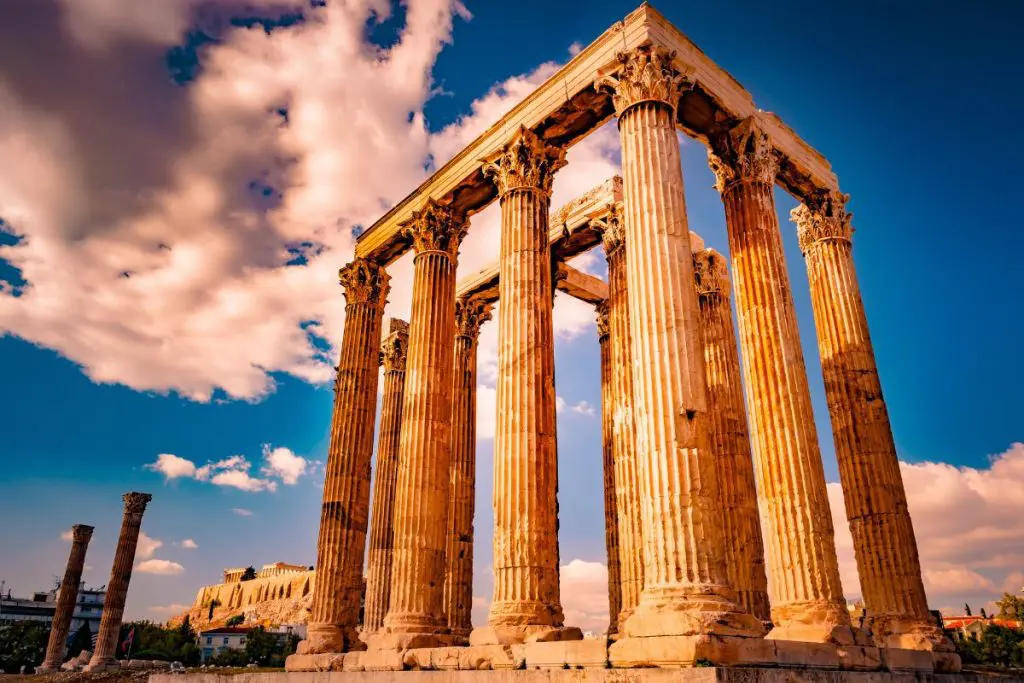
The Temple of Zeus, also known as the Olympieion, is located in Athens, Greece. Specifically, it is situated southeast of the Acropolis, near the Ilissos River. The construction of the temple began in the 6th century BCE during the rule of Peisistratos, but it was not completed until the Roman Emperor Hadrian finished it in the 2nd century CE.
Who Build Temple of Zeus (Olympieion)
The construction of the Temple of Zeus (Olympieion) , began in the 6th century BCE during the rule of the Athenian tyrant Peisistratos. However, due to various historical events and interruptions, the temple was not completed for several centuries.
The temple’s construction was later resumed by the Athenian statesman Antiochus IV in the 2nd century BCE but was still left unfinished. It wasn’t until the Roman Emperor Hadrian took an interest in the project during the 2nd century CE that the Temple of Zeus was finally completed. Hadrian finished the construction and dedicated the temple in 131/132 CE.
So, while the initial construction began under Peisistratos, it was a prolonged and multi-phase project that involved contributions from various leaders over several centuries, with Hadrian ultimately completing the temple during the Roman period.
Things to see at Temple of Zeus (Olympieion)
While the Temple of Zeus, is not as well-preserved as some other ancient Greek structures, there are still notable elements to see at the site in Athens. Here are the key features to observe when visiting the Temple of Zeus:
Columns: The temple was designed to be one of the largest in ancient Greece, with 104 Corinthian columns. Although only a few columns remain standing today, they provide a sense of the scale and grandeur of the original structure.
Ruins of the Temple: Walk around the site to observe the remaining columns and the foundations of the temple. You can get a sense of the size and layout of the Olympieion and imagine its former magnificence.
Hadrian’s Arch: Located just southeast of the temple, Hadrian’s Arch is a monumental gateway built by the Roman Emperor Hadrian to celebrate the completion of the Temple of Zeus. The arch served as a transition from the old city of Athens to the new Roman section.
The Southeast Corner: This is where you can find some of the best-preserved columns. The columns that are still standing showcase the intricate details of Corinthian capitals, characterized by acanthus leaves and volutes.
View of the Acropolis: The Temple of Zeus offers a distant but impressive view of the Acropolis, providing an opportunity to appreciate the ancient city’s landscape.
While the Temple of Zeus may not be as intact as some other ancient Greek temples, it holds historical significance and is a reminder of the architectural achievements of ancient Greece and the later contributions of the Romans. It’s a site worth visiting for those interested in ancient history and classical architecture.
FAQs about Temple of Zeus (Olympieion)
The construction of the temple began in the 6th century BCE during the rule of Peisistratos but was not completed until the 2nd century CE under the Roman Emperor Hadrian.
The Temple of Zeus exhibits classical Greek architectural style, with Corinthian columns and a monumental design.
The temple once housed a colossal gold and ivory statue of Zeus, considered one of the Seven Wonders of the Ancient World. However, the statue is no longer in existence.
Originally, the temple had 104 Corinthian columns. Today, only a few columns and the architrave remain standing.
Hadrian’s Arch, located near the Temple of Zeus, is a triumphal arch built by the Roman Emperor Hadrian to celebrate the completion of the temple.
No, visitors cannot enter the temple’s interior as it is not fully intact. However, the exterior and surrounding area are open to visitors.
Yes, there is usually an entrance fee to visit the archaeological site of the Temple of Olympieion, and fees may vary.
In addition to the temple, visitors can explore Hadrian’s Arch, the Arch of Agrippa, and the nearby National Garden of Athens.
Location on Map
Temple of Hephaestus (Hephaisteion)
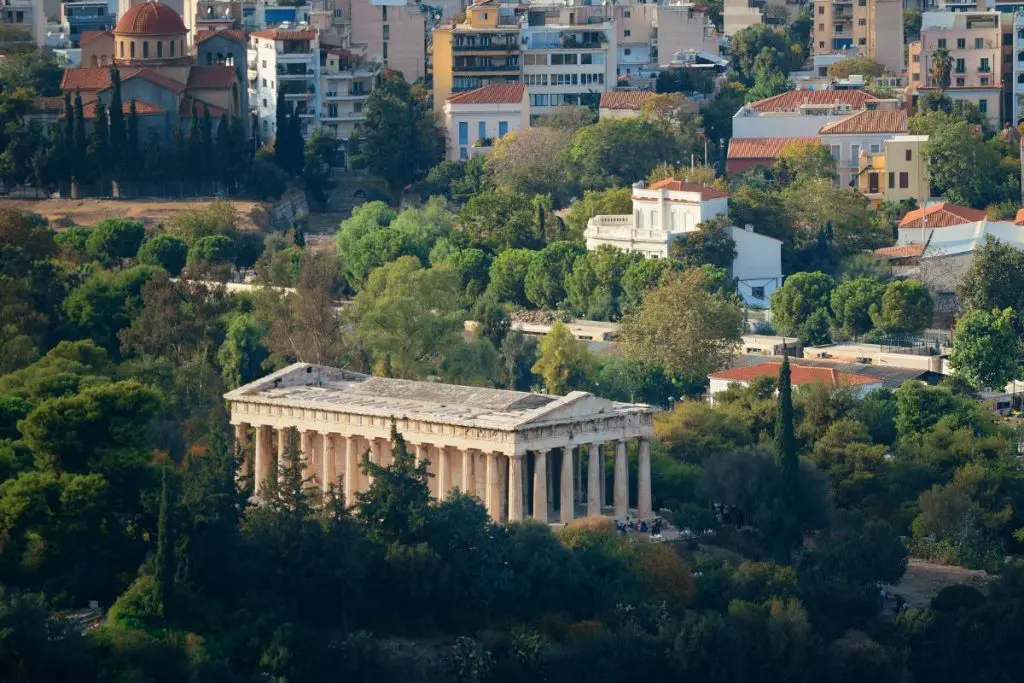
The Temple of Hephaestus, also known as the Hephaisteion or Hephaestus, is located in the Ancient Agora of Athens, Greece. The Ancient Agora is a historical area situated northwest of the Acropolis. The temple is positioned on the northwest side of the Agora, and it is one of the best-preserved ancient Greek temples.
Built in the 5th century BCE, the Temple of Hephaestus is dedicated to Hephaestus, the ancient Greek god of craftsmanship and metallurgy, as well as to Athena Ergane, the goddess of arts and crafts. The temple is an excellent example of Doric architecture and features well-preserved columns and friezes.
Visitors to Athens often explore the Ancient Agora to see the Temple of Hephaestus along with other significant structures in the area, gaining insights into the civic, religious, and cultural life of ancient Athens.
Things to see at Temple of Hephaestus (Hephaisteion)
When visiting the Temple of Hephaestus in the Ancient Agora of Athens, you’ll have the opportunity to explore one of the best-preserved ancient Greek temples. Here are some key things to see at the Temple of Hephaestus:
Doric Architecture: The Temple of Hephaestus is an excellent example of Doric architecture, characterized by its sturdy columns and simple, elegant design. Take a close look at the columns, triglyphs, and metopes to appreciate the craftsmanship of ancient Greek builders.
Friezes and Metopes: The friezes and metopes on the exterior of the temple depict various scenes from Greek mythology and legends. These carved reliefs provide insights into the stories and beliefs of the ancient Greeks.
Pronaos and Opisthodomos: Explore the temple’s porch (pronaos) and rear chamber (opisthodomos). The opisthodomos served as a storage area for temple treasures and was often used for cult activities.
Interior of the Temple: While the interior of the Temple of Hephaestus is not as well-preserved as the exterior, you can still enter the temple and imagine its original purpose and use for religious ceremonies.
Views of Athens: The Temple of Hephaestus offers a vantage point from which you can enjoy views of the surrounding area, including parts of the Ancient Agora and the city of Athens. Take some time to appreciate the landscape and visualize how the temple was situated within the broader context of the ancient city.
Exploration of the Ancient Agora: Since the Temple of Hephaestus is located within the Ancient Agora, take the opportunity to explore the entire archaeological site. The Agora was the central marketplace and civic center of ancient Athens, and it includes other significant structures such as the Stoa of Attalos, the Bouleuterion (council chamber), and the Temple of Apollo Patroos.
Visiting the Temple of Hephaestus and the Ancient Agora provides a fascinating glimpse into the daily life, culture, and religious practices of ancient Athens. It’s a must-see for history enthusiasts and those interested in ancient Greek architecture.
FAQs about Temple of Hephaestus (Hephaisteion)
The construction of the Temple of Hephaestus began around 449 BCE and was completed in 415 BCE during the Golden Age of Athens.
The temple is attributed to the ancient Greek architect Ictinus, who was also associated with the design of the Parthenon on the Acropolis. It was part of a collaborative effort involving various skilled craftsmen.
The Temple of Hephaestus is an excellent example of Doric architecture, characterized by its sturdy columns, simple design, and triglyph-metope friezes.
The temple is dedicated to Hephaestus, the Greek god of craftsmanship and metalworking, and Athena Ergane, the goddess of arts and crafts.
The Temple of Hephaestus is one of the best-preserved ancient Greek temples, with much of its original structure still intact. It stands as a testament to classical Doric architecture and offers valuable insights into the religious and artistic practices of ancient Athens.
While the interior of the temple is not as well-preserved as the exterior, visitors can explore the pronaos (porch) and opisthodomos (rear chamber). The opisthodomos was likely used for storing temple treasures and conducting cult activities.
Yes, there is usually an entrance fee to visit the archaeological site of the Ancient Agora, which includes the Temple of Hephaestus. Fees may vary, and there are often discounts for students and seniors.
Yes, the Temple of Hephaestus is open to the public, and visitors can explore the archaeological site as part of their visit to the Ancient Agora.
Location on Map
Meteora – Unique Rock Formations
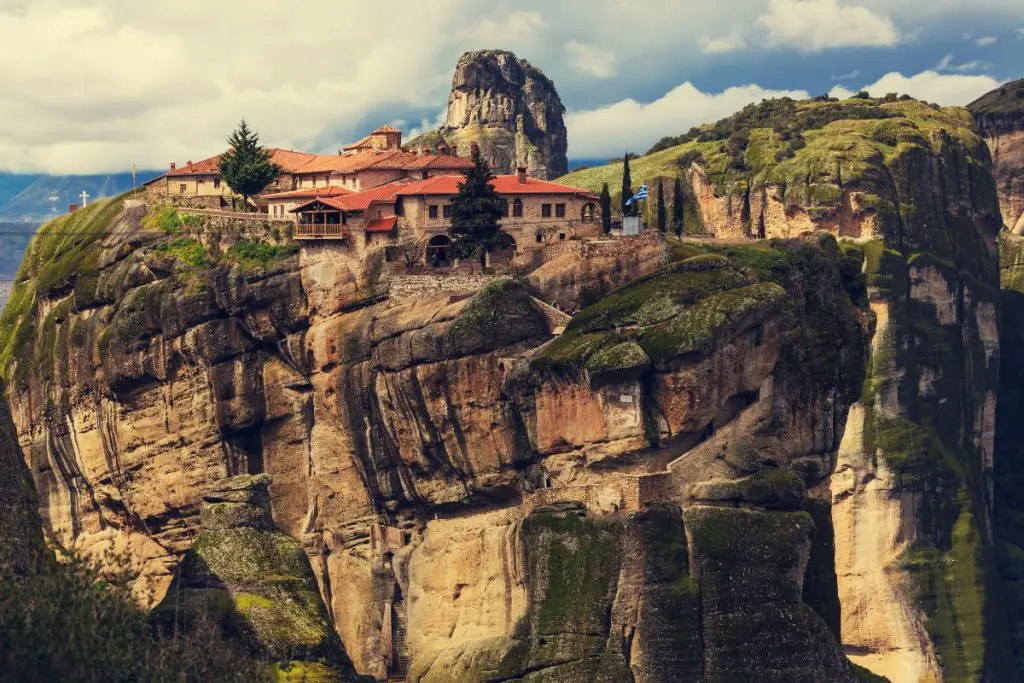
Meteora is a unique rock formation in central Greece, near the town of Kalambaka. It is famous for its monasteries, which are perched on top of towering sandstone pillars. The town of Kalambaka is located at the base of the Meteora rocks, and the site is situated in the Thessaly region, in the central part of the country. The Meteora monasteries are a UNESCO World Heritage site and are known for their stunning natural setting and historical significance.
Things to do in Meteora
Meteora, home to some of the most famous Greek ruins, has stunning rock formations and monasteries perched high above the ground. It offers a unique and enchanting experience for visitors. Here are some things to do in Meteora:
Visit the Monasteries: Explore the monastic complex by visiting some of the active monasteries perched on the top of the towering rocks. The most famous ones include Varlaam, Roussanou, and Great Meteoron. Each monastery has its own charm and unique architecture.
Take a Monastery Tour: Guided tours are available to provide insights into the history, architecture, and spiritual significance of the monasteries. Learn about the daily lives of the monks and the challenges of building and maintaining these structures.
Hiking and Nature Walks: Enjoy the natural beauty of Meteora by taking hiking trails and nature walks. Several paths lead to different viewpoints, providing spectacular panoramic views of the monasteries, valleys, and surrounding landscape.
Rock Climbing: For adventure enthusiasts, Meteora offers excellent rock climbing opportunities. Climbing is permitted, and there are routes suitable for various skill levels. Local guides are available for those new to the sport.
Photography: Capture the breathtaking scenery of Meteora. The changing light throughout the day, coupled with the unique rock formations and monasteries, makes for fantastic photo opportunities.
Sunset Viewing: Experience the magic of Meteora at sunset. Find a vantage point to witness the sun setting behind the rocks, casting a warm glow on the landscape.
Visit Kastraki Village: Explore the charming village of Kastraki, located at the base of Meteora. Stroll through its narrow streets, visit local shops, and experience the warm hospitality of the residents.
Monastery of Agios Nikolaos Anapafsas: Visit this smaller but equally fascinating monastery, known for its beautiful frescoes. It is often less crowded than some of the larger monasteries.
Attend a Religious Service: If your visit coincides with a religious service, consider attending. Some monasteries hold regular services, allowing visitors to experience the spiritual atmosphere of these sacred places.
Visit the Natural History Museum of Meteora and Mushroom Museum: Learn about the geological history of the region and discover the rich flora and fauna. The Mushroom Museum provides insights into the local mushrooms and their importance.
Cycling: Rent a bike and explore the area around Meteora. Cycling is a great way to enjoy the scenery and cover more ground.
Explore Theopetra Cave: Visit the nearby Theopetra Cave, an archaeological site with traces of human habitation dating back thousands of years. It provides a glimpse into the prehistoric past of the region.
FAQs about Meteora
Meteora is accessible by train or bus from major cities like Athens and Thessaloniki. The nearest town is Kalambaka, situated at the base of the rocks. Visitors can then travel by bus or taxi to reach the monasteries.
There are six active monasteries in Meteora: Great Meteoron, Varlaam, Roussanou, St. Nicholas Anapafsas, St. Stephen, and Holy Trinity. These monasteries date back to the 14th century.
Yes, visitors are allowed to enter the monasteries. However, there is a dress code, and shoulders and knees must be covered. Some monasteries have specific visiting hours and may be closed on certain days.
Yes, there are hotels and guesthouses in Kalambaka and Kastraki, the towns at the base of Meteora. Accommodations range from budget-friendly options to more luxurious hotels.
When visiting the monasteries of Meteora, Greece, a dress code is in place. Men are required to wear long pants, while women should wear long skirts. Sleeveless shirts are not permitted. However, if you don’t have appropriate attire, skirts and trousers are available at the entrance of the monasteries for visitors to use.
The Meteora hike is generally categorized as moderately challenging, with an average completion time of 1 hour and 54 minutes. As a popular hiking destination, it is common to encounter other hikers along the route.
Location on Map
Theatre of Epidaurus
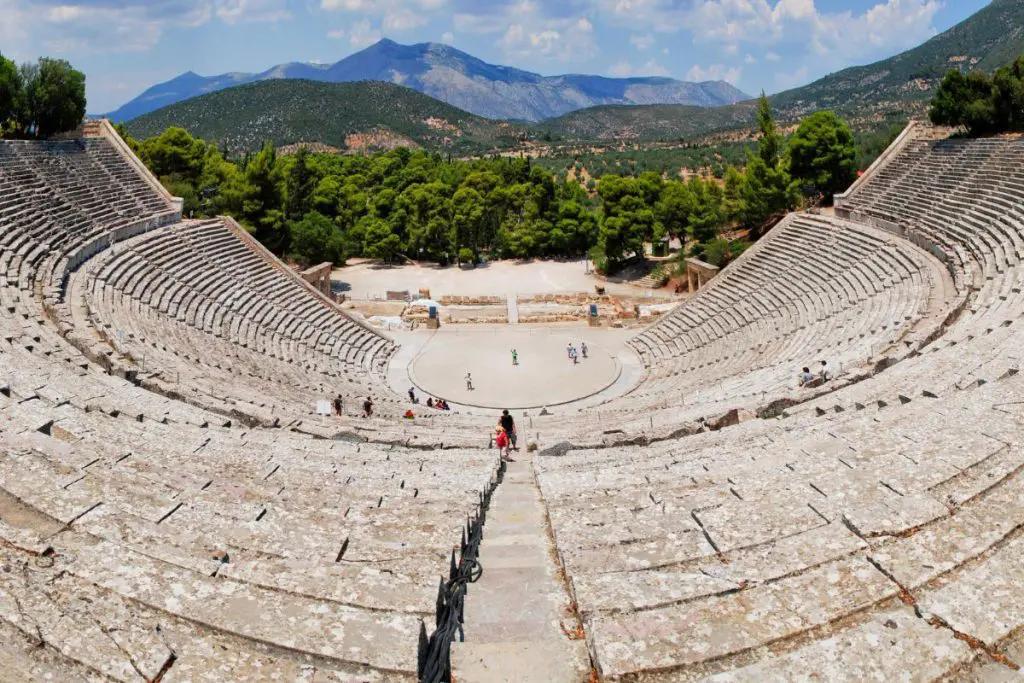
The Theatre of Epidaurus, also known as the Ancient Theatre of Epidaurus, is located in the sanctuary of Asklepios at Epidaurus, in the northeastern part of the Peloponnese peninsula in Greece. It is situated near the modern town of Epidavros (Epidaurus in Greek), which is part of the municipality of Epidaurus in the regional unit of Argolis. The theatre is renowned for its exceptional acoustics and well-preserved ancient Greek architecture, making it one of the most significant and well-known ancient theatres in the world.
Who Build Theatre of Epidaurus
The Theatre of Epidaurus was built in the 4th century BCE, during the Classical period of ancient Greece. The architect responsible for its design is not definitively known, as the construction predates recorded historical documentation for many ancient structures. The theatre is, however, commonly attributed to the architect Polykleitos the Younger, who was active in the 4th century BCE.
Polykleitos the Younger was the son of the famous ancient Greek sculptor Polykleitos, known for creating the Doryphoros (Spear Bearer) statue. While there is no direct evidence linking Polykleitos the Younger to the Theatre of Epidaurus, historical sources suggest that he was involved in various architectural projects during that time, and his influence on the theatre’s design is a plausible attribution.
Things to do near Theatre of Epidaurus
The Ancient Theatre of Epidaurus is located in a region rich in history and natural beauty. Here are some things to do near the Ancient Theatre of Epidaurus:
Visit the Sanctuary of Asklepios: Explore the archaeological site of the Sanctuary of Asklepios, which includes the famous Theatre of Epidaurus. This sanctuary was dedicated to Asklepios, the god of healing, and features various temples and structures.
Epidaurus Museum: Discover artifacts and sculptures from the ancient sanctuary at the Epidaurus Museum, providing additional context and insight into the religious and cultural practices of the region.
Asklepios Ancient Theatre Festival: Check the schedule for the annual Epidaurus Festival, where performances, including ancient Greek tragedies and comedies, are staged in the Theatre of Epidaurus during the summer months.
Mycenae: Visit the ancient archaeological site of Mycenae, an important center of Mycenaean civilization. Explore the ruins of the citadel, including the famous Lion Gate and the Treasury of Atreus.
Nafplio: Explore the charming town of Nafplio, known for its picturesque old town, historical architecture, and waterfront promenade. Visit the Palamidi Fortress and the Bourtzi Castle situated on small islands in the harbor.
Tolo Beach: Relax on the nearby Tolo Beach, a popular seaside destination with sandy shores and crystal-clear waters. It’s an ideal spot for swimming, sunbathing, and enjoying the Mediterranean atmosphere.
Ancient Epidaurus Little Theatre: If available, attend a performance at the Ancient Epidaurus Little Theatre, which is part of the Asklepieion complex. This smaller theatre is also used for cultural events and performances.
Archaeological Site of Tiryns: Explore the archaeological site of Tiryns, another Mycenaean fortress city located near Nafplio. The site includes impressive Cyclopean walls and archaeological remains.
Hiking and Nature Exploration: Take advantage of the hiking trails and nature walks in the surrounding area. Enjoy the scenic landscapes and perhaps hike to vantage points offering views of the Argolic Gulf.
Try Local Cuisine: Indulge in the local cuisine of the region. Visit traditional tavernas in nearby villages to savor authentic Greek dishes and regional specialties.
Ligourio and the Ancient Theater of Hermione: Visit Ligourio, a village close to Epidaurus, and explore the Ancient Theater of Hermione. This smaller theatre is another historical site worth exploring.
Wine Tasting: The region is known for its wine production. Consider visiting local wineries to taste regional wines and learn about the local viticulture.
FAQs about Ancient Theater of Epidaurus
The theatre has a seating capacity of approximately 14,000 spectators. It is renowned for its unique acoustics, where even a whisper on stage can be heard throughout the entire auditorium.
The architect responsible for the design of the theatre is not definitively known. It is commonly attributed to Polykleitos the Younger, an ancient Greek architect, although this attribution is based on historical speculation.
The theatre hosted various performances, including ancient Greek tragedies, comedies, and religious ceremonies dedicated to Asklepios. It was an integral part of the healing rituals and festivals in the sanctuary.
Yes, the Ancient Theatre of Epidaurus is still in use today for various performances. It hosts the annual Epidaurus Festival during the summer months, featuring classical Greek plays, dramas, and other cultural events.
Yes, there are facilities for visitors, including restrooms and concessions. However, it’s recommended to check specific details and availability during your visit.
Location on Map
 Black Friday: 60% Off
Black Friday: 60% Off Croatia Sailing : Save up to 60%
Croatia Sailing : Save up to 60% Ski Bansko : 60% Off
Ski Bansko : 60% Off Central & Eastern Europe Tours: 60% Off
Central & Eastern Europe Tours: 60% Off  Why Travel Talk
Why Travel Talk Travel Talk Blog
Travel Talk Blog Responsible Travel
Responsible Travel Fair Travels with Travel Talk
Fair Travels with Travel Talk